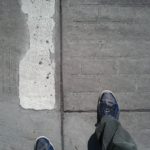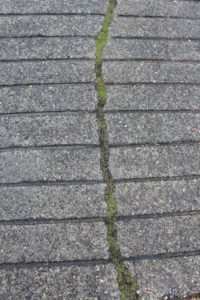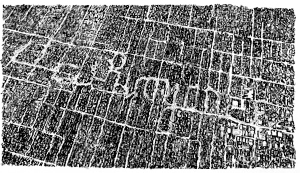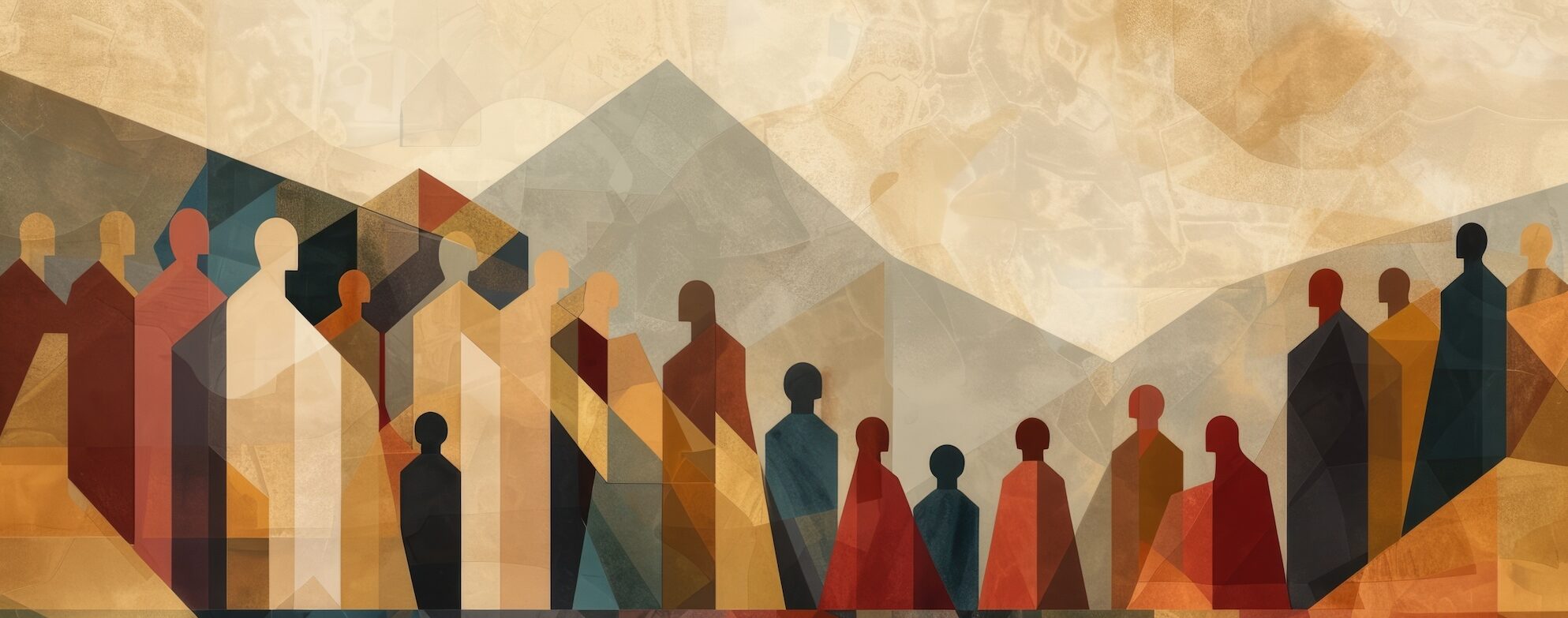These drawings are representations of two walks I performed through the Greenwood neighborhood of Seattle. I recorded the walk with the GPS tracker on my smartphone, thus using the phone as the pen, and my feet as the kinesthetic for manipulating the pen, in an act of writing. The word here that I walked, clairvoyance, is written in blue, represented as the GPS recorded it.
I am weary, and so today I go for a walk. 
It is November, which means we have passed into the rainy season in the Pacific Northwest. The daylight at this time of year never achieves a full brightness; greyness suffuses the already grey pavement of the road and the drab concrete structures around me. Everything is grey, somber and humorless, which makes it feel as though I only perceive a partial opacity of reality.
Not fully illuminated, but as though I am living in a Photoshopped image where the hue and saturation bars have been adjusted downward. Pavement covers the earth, nature only appearing as mosses and single blades of grass through the broken cracks of the sidewalk, or in neglected garden planters in the parking strips of the homes I walk past, full of bolted spring lettuces and weeds. I think about how the world is mediated by our structures; that is, our experiences of life are only experienced through layers. My feet never touch real earth like soil or grass or rock, but rather the hard concrete carpets rolled out for our travels, built for wheels and not for feet. Socks and shoes are also layers of mediation, “protecting” the skin of my feet from direct contact with the ground.
or in neglected garden planters in the parking strips of the homes I walk past, full of bolted spring lettuces and weeds. I think about how the world is mediated by our structures; that is, our experiences of life are only experienced through layers. My feet never touch real earth like soil or grass or rock, but rather the hard concrete carpets rolled out for our travels, built for wheels and not for feet. Socks and shoes are also layers of mediation, “protecting” the skin of my feet from direct contact with the ground.
This walk I am taking is entering its seventh mile, though as the crow flies I’ve only traveled a couple of square miles. Today however I am not simply walking from point A to point B. Today’s path is irregular. For example, at this moment I am thinking about my approach to writing the letter N. I have walked the vertical leftmost line by moving northward, and now I head southeast so as to write the downward diagonal line of the letter. At the bottommost point I will then turn and head straight north again, walking (writing?) the final part of the letter. I choose to write a capital N at this point of my walk, though I am on the tenth letter of this twelve-letter word and not the first. It’s simply a particularity of my writing utensil; walking a smaller case n within the street grid structure of the neighborhood causes the letter to lose its subtle curves and become illegible. Thus the word I write today becomes a necessary hybrid of capital letter and cursive writing. I envision in my head the word I’ve walked thus far, doing so by memory of the past couple of hours of my walk, and I can sense already it will be far from legible. I began writing this word too far to the north, and walked too far south, and so the C is horizontally elongated. I took a wrong turn after writing the letter I, and have had to improvise the rest of the word ever since, attempting to cover up my mistake.The word has in essence bumped up a block, giving the word an uneven level as if one were writing on a lined sheet of paper and suddenly jumped mid-word to the line below it. I also forgot to complete the letter A, leaving a large gap. A writing instructor would have a field day critiquing the legibility of my writing (walking?). I’ve mostly given up on the word being easily readable, though one I hope might be able to work it out on a map, if one is willing to struggle with me through my mistakes. The thing is, this is not my word. This word I am walking did not originate with me. The ideas, the meaning, are not mine. I don’t own it, but rather this word comes from someone else, and I am now walking it, trying my best to delicately carry this word, via bodily movement as well as my thoughts as I write it through the urban landscape.
Today I am weary of walking my own words. I am taking a different tack and attempting to walk someone else’s word. This word came from conversation with a friend. We shared stories one night in a pub, discussing how we came to be in Seattle and the paths and choices that brought us to this moment and place. The word of resonance for both of us, negotiated through our conversation, was clairvoyance. The definition of this word finds simultaneous meaning in both the moment and in the lifelong journey.
We think of clairvoyance as a moment of clarity, when all of one’s trials and questions make sense, when the totality of one’s existence finds ultimate meaning.
My friend described these moments of clarity for herself as blackouts; literally, all went dark for her and self-consciousness ceased. One is reminded of the Biblical story of Saint Paul, who is struck blind on the Road to Damascus. Contemporary thinkers such as Leonard Lawlor and Alain Badiou show fascination with this story. For Lawlor, this is a conversion of “corporeal vision” to “a process of becoming.” Badiou writes, “Truth is a process, not an illumination.” I think of the act of walking, which is simply moving, as also the process of pilgrimage; moving is a process of becoming. We each journey through our lives, collectively creating our world in this process, and as I walk I begin to understand that truth, the really-real, is perhaps not an illuminated ideal but rather is simply an immanent encounter in a moment of presence within this process of movement. Further representation of ideals is not needed, in a world saturated with such things, but perhaps rather a practice of movement. This practice embodies a process of moving through ideas and relationships on our collective pilgrimage. In this we create possibilities, performing acts and prayers of generosity and hospitality to one another.
I am weary of placing my own words forward as an individual projection, for we are far too familiar with walking our own words, taking the standard tropes one chooses to comprise the many-filtered lens of cogito through which to view the world and through which to define others. This word I embody is a hope that emanates out of relation with others (not ‘to’ others), to allow myself to be of service, to be myself changed as I walk, recreated even in every step. If this recreation can occur in the minute space of one person’s walk through the totality of an urban landscape, then perhaps the world carries inherent potential for recreation as well.
I take comfort even in my wrong turns, in an illegibly written word, as the prophet Isaiah says, “Whether you turn to the right or turn to the left, your ears will hear a voice behind you, saying, ‘This is the way; walk in it.’”


